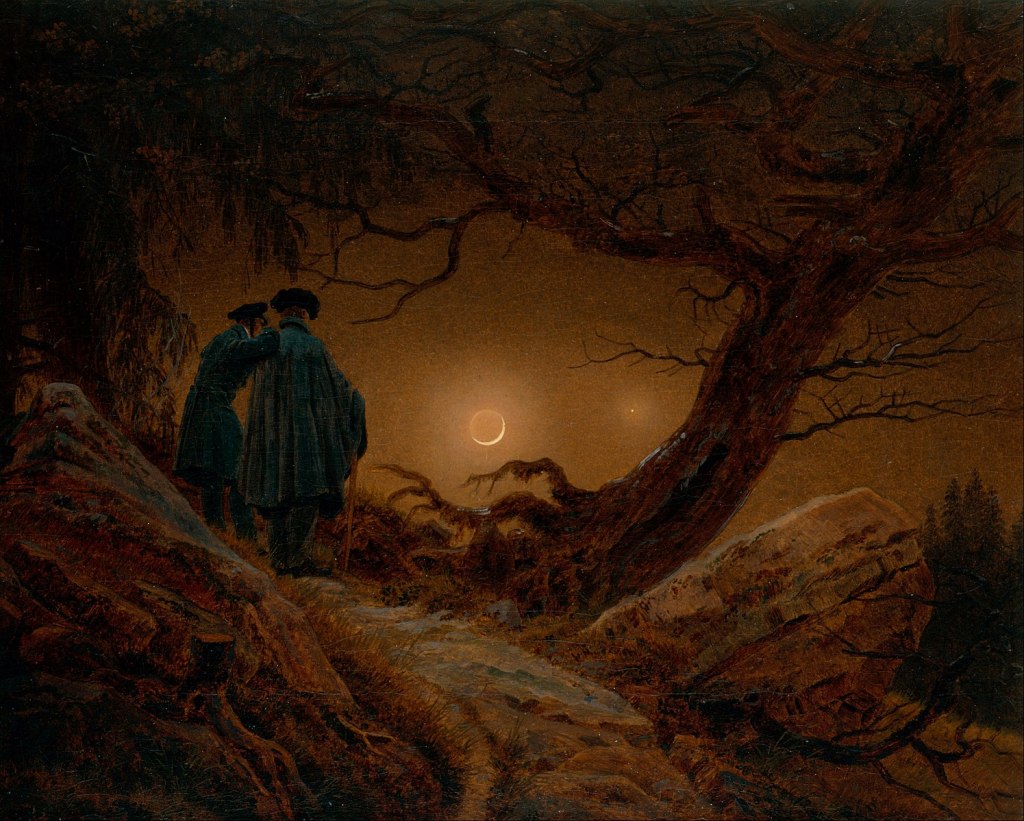This month celebrates a month with two full moons. The first on October 1st and the second on October 31st, Halloween, a so-called blue moon.
With four planets ruled by the moon in my own astrological chart, I am particularly stirred by Luna’s lure and lore, like many other artists, writers, and painters alike, who are also inspired by the moon’s mystique.
Casper David Freidrichs’s painting, “Two Men Contemplating the Moon”, circa 1825, portrays the artist and his friend and disciple, August Heinrich, in a dreamy landscape. The moon was a popular subject of fascination among the German Romantics who regarded the motif as an ‘object of pious contemplation.’

But artists, spanning all eras and continents, have found equal interest in depicting the moon in all her phases and moods; over the water with boats, behind mountains or clouds, peeking through forests, or floating atop city buildings.
Included among the many artworks is Michelangelo’s fresco, ‘Creation of the Sun Moon and Planets,’ in 1511, Henry Pether’s ‘Venice by Moonlight’, circa 1850, and Claude Joseph Vernet’s painting from 1771, ‘Night: Seaport by Moonlight’.

In fact, in the last decade, three art museums have organized exhibits around the ‘la luna’.
To celebrate the 50th anniversary of the Apollo 11 moon landing, The Metropolitan Museum of Art presented a photography exhibit in 2019 called Apollo’s Muse: The Moon in the Age of Photography, which included a selection of related drawings, prints, paintings, films, astronomical instruments, and cameras used by Apollo astronauts.
“The images collected here read like a love letter from all [the moon’s] ardent suitors,” wrote the New York Times.
The Wall Street Journal wrote, “Such photos are also a way of expressing artistic imagination and capturing our fantasies about the moon…an age-old symbol of mystery and desire.”


Galileo Galilei (Italian, Pisa 1564–1642 Arcetri outside Florence)

Francisco Fontana (Italian, Naples 1580–1656 Naples)
The Peabody Essex Museum in Salem, Massachusetts curated Lunar Attraction in 2017, an exhibit featuring around 60 historical and contemporary objects ‘considering the enduring artistic curiosity for the mysteries of the moon’.
“So few people seem to pay much attention to the moon, despite its role in our planet’s daily rhythms, human history, and as an enduring muse for artists and musicians,” said Janey Winchell PEM’s Sarah Fraser Robbins Director of the Art & Nature Center, where the exhibition is on view, “I wanted to put the moon on stage for a bit, so people might experience Earth’s constant companion from a new vantage point, which artists do so well.”
“We wanted to give adults and families alike different ways of engaging with the moon, both as a physical entity and as something that has inspired countless artists from across the globe and for over a millennia.”

American artist Laurie Anderson, the first artist in residence at NASA, collaborated with new media Taiwanese artist Hsin-Chien Huang on the VR artwork ‘To the Moon’ in 2019, allowing the audience to experience the marriage between art during a simulated journey of an astronaut under low-gravity conditions.

“The moon, as an aesthetic symbol, will be handed down from artist to artist, century to century, like a secret scrying crystal – a lens through which the soul of an era can be brought into mystical focus,” writes Kelly Grovier, American poet, historian, and art critic, “The moon can only be appreciated anew if we strip away what we think we know about it and about ourselves. Like all great works of art, To the Moon aims to facilitate the finding of oneself through a paradoxical process of self-loss.”
Interestingly ‘Clair de Lune,’ a poem that was written by Paul Verlaine in 1869 and translates to ‘the moon’s light,’ later inspired Claude Debussy’s famous piano composition of the same name, as if passing the torch, some 20 years later. How many artists have been moved to create while listening to that ethereal composition?
Verlaine’s original Clair de Lune reads:
“Your soul is a chosen landscape, where charming masqueraders, and bergamaskers go playing the lute and dancing and almost, sad beneath their fanciful disguises.
All sing in a minor key, of victorious love and the opportune life, they do not seem to believe in their happiness and their song mingles with the moonlight.
With the still moonlight, sad and beautiful, that sets the birds dreaming in the trees and the fountains sobbing in ecstasy, the tall slender fountains among marble statues.”
When Debussy put to music his wistful piano rendition of the poem by the same name, Clair de Lune, the third movement of the Suite ‘Bergamasque,’ was he thinking of Camille Claudel, the sculptress, and her emotive marble statues? Did she embody the ‘sad and beautiful’ with her fierce Sagittarian fire, burning in flames that never let her surrender?
The enchantment of the moon is perhaps a metaphor of how artists and inspiration work – we too receive light from a greater source, be it nature, religion, God, beauty, or love, and then we reflect this light into the darkness, inspiring and guiding each other.
Contemplating the impact of the moon on humanities, arts, and culture reminds me of a very vivid dream I had years ago.
The dream is set at nighttime. I am walking in a forest clearing when something falls onto my head. I realize that it’s the moon, which has fallen out of the sky. It hits the ground, cracking open like an egg, revealing a structure made of chicken wire and newspaper like a paper maché high school play prop.
This initially delights me, ‘What amazing auspicious luck, to be hit by the moon!’ But the feeling turns quickly to a terrible realization – there is no more moon in the sky for lovers and poets to gaze upon. I become determined that, somehow, I must get the broken and hollow moon back into the sky.
For ages the moon has continued to inspire artists, poets, and mystics, enchanting children and lovers, offering hope and beauty. We must therefore work to keep it in the sky for all to see. We should always remember that the moon shines its ‘pure’ light without judgment, ever dynamic, eternal, and enduring.
Poets like Sanober Khan, from his collection of free verse poems, Turquoise Silence wrote:
it was the kind of moon
that I would want to
send back to my ancestors
and gift to my descendants
so they know that I too,
have been bruised…by beauty.



Leave A Reply